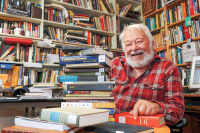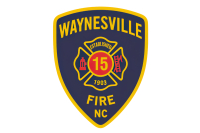Park or promoter? Parkway looks for high ground in new role of peddling tourism
The Blue Ridge Parkway plans to build a visitor center outside Asheville in coming years that will provide information on the Parkway and become a tourist outpost for all of Western North Carolina.
The new center will include high-tech, interactive exhibits about the construction of the Blue Ridge Parkway and the natural and human history of the region. The center will also provide information on things to see and do in communities along the Parkway.
Construction could begin in spring and take 18 months, with the center opening as early as fall of 2007 if funding comes through. The projected cost is $10 million. Congress has allocated $1 million for planning and $3 million for construction. U.S. Rep. Charles Taylor, R-Brevard, is a fan of the Parkway visitor center. Taylor is chairman of the appropriations subcommittee in charge of National Park Service funding and could see to it the money comes through.
Some critics have questioned whether the Blue Ridge Parkway, a unit of the National Park Service, should play a role in promoting commercial activities and attractions. The National Park Service has typically guarded against a park visitor center serving as a tourism site for surrounding communities. The mission of the National Park Service is to share natural and cultural resources of the park with the public.
The ParkwayÕs somewhat unprecedented foray into this new role for a national park sparked opposition from the National Parks Conservation Association, and the Parkway has since tempered that focus.
We were concerned initially with the focus of the visitor center being on where you could stay, where you could eat, where you could play golf, said Greg Kidd, the associate southeast regional director of the National Parks Conservation Association. That is not what the park service is responsible for providing. The local chambers of commerce are responsible for providing that kind of information. It is clear the Parkway listened to those concerns and backed off from making it so focused on providing information on commercial enterprises.
Phil Noblitt, spokesperson for the Blue Ridge Parkway, said thatÕs not the ParkwayÕs intention.
A lot of people were uptight that this was going to be strictly about marketing, said Noblitt. But Noblitt said the purpose is not selling tourists on specific attractions.
It is more about selling people on what a wonderful region this is, Noblitt said. We want to help orient people and give people a sense of what is special about Western North Carolina.
At the same time, the Parkway provides a vital link to towns dependent on tourism, and the Parkway shouldnÕt ignore that, Noblitt said.
Tourism is an ever-increasing part of this regionÕs bread and butter, Noblitt said. We want to recognize that and at the same time recognize the Parkway as a gateway to the communities that are along it. We become a gateway to Waynesville, to Cherokee, to Asheville, to Spruce Pine, to Boone.
The devil is certainly in the details, however. Exactly how promotion of activities off the Parkway will be handled remains to be seen. Will HarrahÕs Cherokee Casino get equalbilling with the Biltmore Estate? Will downtown Asheville get better placement than information on downtown Sylva? Will WaynesvilleÕs Folkmoot USAÕs international dance festival be promoted on equal footing with AshevilleÕs Bele Chere? Will all 20 rafting outfitters in the Nantahala Gorge have equal access to brochure rack space?
The leading idea is to use a feature called an i-wall, a new multi-media invention that stands for an intelligent, information, interactive wall.
We thought about using higher tech stuff where you could access information that would not require posting walls and walls of brochures, Noblitt said.
For example, an i-wall could feature general information about whitewater rafting as a popular activity in the region without promoting one rafting company. Tourists with the initiative to book a rafting trip could then stroll over to an individual Internet kiosk and do so.
The mega visitor center has been a dream of the Parkway for almost two decades. The plan pitched in the 1990s called for an IMAX movie theater with more than 300 seats, a commercial endeavor that would be an unusual feature for a unit of the National Park Service.
If entrepreneurs wanted to develop a regional visitor center with an IMAX theater outside the boundary of the Parkway that would be their prerogative, but to have something like that on the Parkway is totally inappropriate, Kidd said.
The plan pitched this time around called for a 250-seat digital immersion theater, a description that sounded an awful lot like an IMAX theater to Kidd. Public opposition to a theater of that scale led the Parkway to downsize it to a 75-seat theater, which Kidd said is the appropriate scale and will be a great asset for visitor education.
Asheville-centric?
The visitor center, technically called a regional destination center, will be built outside Asheville beside the new Blue Ridge Parkway headquarters. The visitor center could work for or against towns further west. Some tourists who reach the visitor center could be lured off the Parkway to venture into Asheville instead of continuing along the Parkway to Waynesville, Sylva, Maggie Valley or Cherokee.
But it could have the opposite effect on tourists, encouraging them to keep exploring the Parkway after learning about destinations and things to do west of Asheville.
Will there be some things on what to do and see in the neighboring communities and will that include Asheville? Yes, but the focus of this is a regional destination center, Noblitt said, adding that the destination center will be purely beneficial, not detrimental.
When the Parkway conducted public input meetings during the planning stages of the visitor center, the first question asked in a survey was What are some characteristics that you value most about the Blue Ridge Parkway in the Asheville region? Another question on the survey was What should be the most important programmatic goals for the Asheville area Regional Destination Visitor Center? and not the WNC area Regional Destination Center.
To a certain extent, communities west of Asheville have failed to jump on the bandwagon and get involved in the planning process for the visitor center. The Asheville Chamber of Commerce asked for a strategic planning meeting with Parkway officials and attended the public input session, whereas other chambers of commerce in the region did not.
The visitor center will also serve as the headquarters for the Blue Ridge National Heritage Area, a designation bestowed on 25 counties in WNC by Congress two years ago. The Blue Ridge National Heritage Area is poised to receive millions in federal dollars to promote the cultural and natural heritage of WNC.





